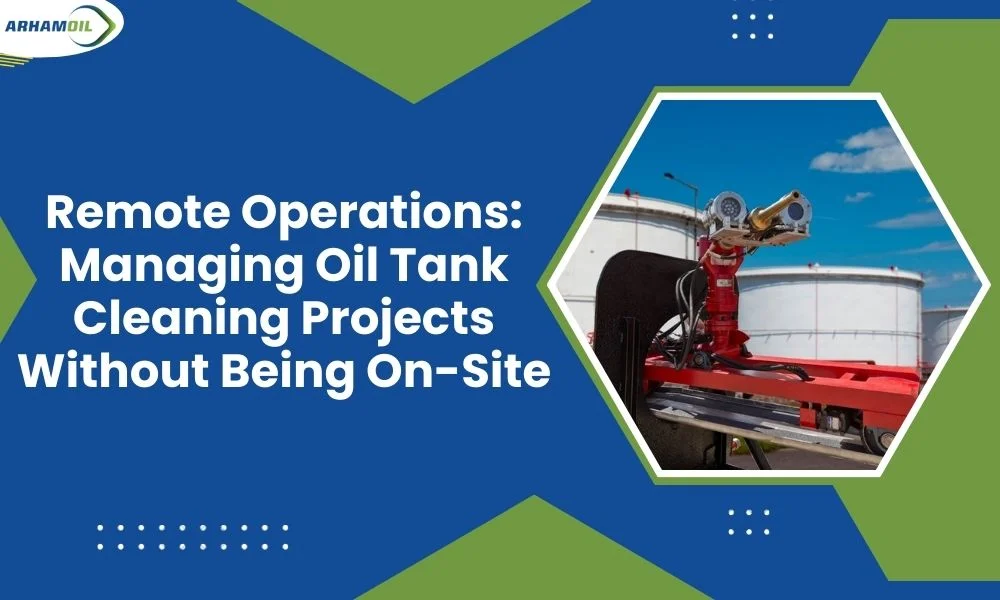The Future of Oil Sludge Management: Trends to Watch in 2025 and Beyond
May 14, 2025Robots in the Oil Industry: Why Human Hands Are No Longer Needed in Hazardous Cleaning Jobs
May 28, 2025The New Era of Oil Tank Cleaning
Picture this: A refinery manager in Texas oversees the cleaning of a crude oil storage tank in Saudi Arabia, without leaving their office. No flights, no safety harnesses, no delays. This isn’t science fiction; it’s the reality of remote oil tank cleaning, a game-changer for the energy industry.
At Arham Oil, we’ve spent years perfecting remote operations to deliver safer, faster, and more cost-effective tank cleaning. In this blog, we’ll pull back the curtain on how remote management works, why it’s essential for modern operations, and why partnering with us guarantees unmatched results.
The Problem with Traditional On-Site Management
For decades, tank cleaning required boots on the ground. Teams traveled to sites, entered hazardous confined spaces, and managed slow, labor-intensive processes. The challenges?
- Safety Risks: Workers faced toxic fumes, explosions, and physical strain.
- Costly Delays: Travel, permits, and unexpected issues dragged projects out for weeks.
- Inconsistent Expertise: On-site teams varied in skill, leading to errors or incomplete cleaning.
In 2025, these inefficiencies will no longer be acceptable, not when remote technology offers a smarter way.
How Remote Oil Tank Cleaning Works
Remote operations blend advanced hardware, software, and expertise to manage projects from anywhere. Here’s how we do it:
Step 1: Robotic Deployment
- Pre-Configured Robots: We ship ATEX-certified robots to your site, pre-programmed for your tank’s specifications.
- Plug-and-Play Setup: Local crews (or our partners) install robots in hours—no specialized training needed.
Step 2: Real-Time Monitoring & Control
- Live Dashboards: Access 24/7 feeds from robots’ HD cameras, LiDAR scans, and gas sensors.
- Remote Control: Our operators (or your team) adjust cleaning parameters (e.g., jet pressure, suction speed) from a secure cloud platform.
Step 3: AI-Driven Optimization
- SmartSludge AI™: Our proprietary software analyzes sludge density and corrosion in real time, auto-adjusting robot paths for maximum efficiency.
- Predictive Alerts: Get notified of potential issues (e.g., equipment wear) before they cause downtime.
Step 4: Waste Handling & Reporting
- Automated Recycling: Robots separate oil, water, and solids onsite. We coordinate with local partners to recycle 95% of waste.
- Instant Compliance Reports: Download OSHA and EPA-ready documents post-cleaning.
Key Technologies Powering Remote Operations
Remote management isn’t just about video calls—it’s a symphony of innovations:
- IoT Sensors: Monitor tank conditions (temperature, gas levels) and robot performance in real time.
- 5G Connectivity: Enables lag-free control from thousands of miles away.
- Cloud Platforms: Securely store data, share reports, and collaborate with stakeholders globally.
- Digital Twins: Virtual replicas of tanks let engineers simulate cleaning strategies before deployment.
Why We Stand Out:
- Military-Grade Encryption: Protect sensitive data from cyber threats.
- Global Support Network: Local technicians assist with hardware setup in 50+ countries.
5 Reasons to Switch to Remote Operations
1 Eliminate On-Site Risks
- No Human Entry: Workers avoid toxic sludge, confined spaces, and explosions.
- Zero Travel: Manage projects from your desk, reducing COVID-19 or geopolitical risks.
2. Slash Costs by 40–60%
- Labor Savings: Fewer personnel onsite = lower wages, insurance, and travel expenses.
- Faster Turnarounds: Robots work 24/7, cutting downtime from weeks to days.
3. Unmatched Consistency
- Standardized Processes: Our AI ensures every inch of the tank meets the same high standard.
- Global Expertise: Tap into our engineers’ decades of experience—no matter your location.
4. Scalability
- Manage Multiple Sites: Oversee tank cleaning in Texas, Singapore, and Angola simultaneously from one dashboard.
- Flexible Contracts: Scale services up or down with demand via our Robot-as-a-Service (RaaS) model.
5. Sustainability Boost
- Lower Carbon Footprint: Reduce travel emissions and energy use.
- Closed-Loop Recycling: Convert sludge into biofuels, aligning with ESG goals.
Why Arham Oil Leads the Remote Revolution
Many claim to offer remote services, but here’s why we’re the only partner delivering results:
Proprietary Tech You Can’t Find Elsewhere
- AdaptiveJet™ Nozzles: Automatically adjust pressure for paraffin, sand, or heavy sludge.
- SmartSludge AI™: The only system that learns from each project, improving efficiency over time.
Proven Safety Record
- Zero Incidents: No injuries or spills across 500+ remote projects since 2018.
- ATEX/IECEx Certified: Robots rated for explosive environments.
Global Reach, Local Expertise
- 50+ Countries Served: From Arctic sites to desert refineries, we adapt to local challenges.
- 24/7 Multilingual Support: Get help in English, Arabic, Spanish, or Mandarin.
Transparency Guaranteed
- Live Progress Tracking: Clients log in anytime to see robot status, sludge volume removed, and costs.
- No Hidden Fees: All-inclusive pricing covers robots, recycling, and compliance.
Case Example: A Cross-Continent Success
A European energy firm needed to clean tanks in Nigeria but couldn’t send staff due to travel bans. With our remote services:
- Day 1: Robots deployed via Lagos-based partners.
- Day 3: The Remote team in Germany began scrubbing tanks via 5G-connected dashboards.
- Day 7: Cleaning completed; sludge shipped to a local recycling partner.
- Result: 60% cost savings, zero travel, and full OSHA compliance.
The Future is Remote—Are You Ready?
Remote oil tank cleaning isn’t a trend; it’s the new standard. Companies clinging to on-site methods face rising costs, safety scandals, and operational delays.
We’ve redefined what’s possible. Our blend of AI, robotics, and global expertise lets you clean tanks faster, safer, and smarter—no travel required.
Take the First Step Today:
Contact Us to see our remote system in action. Let’s transform how you manage tank cleaning—together.


